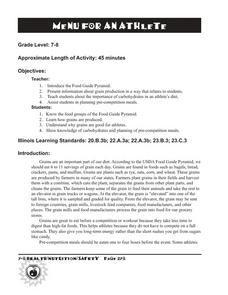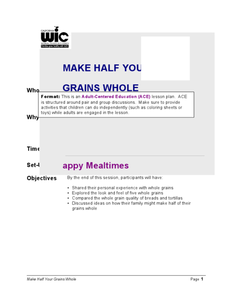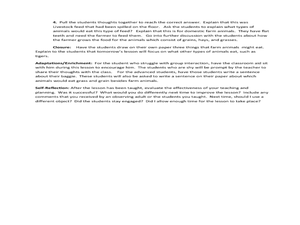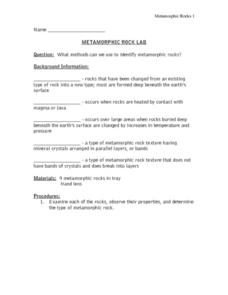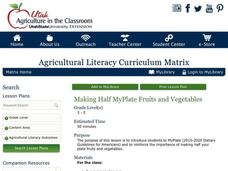Education Outside
What Are Grains?
This activity is like having a show-and-tell. Bring in lots of items, or packaging, from the grain group. Bread, rice, cracker, cereal, oats, you get the idea. Perhaps first start by checking in and asking what the class knows about...
Curated OER
What is Sand?
Learners complete a sand analysis project. In this sand grains lesson, students learn background information on how sand is formed and what sand grains are made of. Learners are given bags of sand and use them to complete a...
Curated OER
Menu for an Athlete
Football, basketball, softball. What do these sports have in common? Athletes. Young scholars learn about and discuss the food pyramind, especially grains, with the thought that they will be planning a pre-competition meal and snack for...
Curated OER
Economics: What Are Some Other Uses for Rice?
Sixth graders investigate ways rice is sold by creating a chart of the different rice foods. In this economics lesson, 6th graders examine their local food store and list at least 10 rice by-products in a class chart. Students discover...
Curated OER
Your Energy In
What are Dietary Guidelines? What are the basic principles of a sensible healthy diet? What do variety, balance, and moderation have to do with eating healthy. What are the food groups? There are a couple of activities in this lesson...
Curated OER
What was the lesson learned in the story, "One Grain of Rice?"
Second graders complete activities with the folktale "One Grain of Rice." In this folktale lesson, 2nd graders discuss the lesson learned in the story. They also tell character traits of the main character Rani.
Curated OER
Make Half Your Grains Whole
Students discuss the benefits of eating whole grains. For this adult health lesson, students compare samples of whole grain food products. They recommend ways on how to incorporate whole grains in their family diet.
Garden Earth Naturalist Club
Parts of a Flower! Flower Dissection
Sometimes the best way to learn about plants is to see the different parts of a plant yourself. Groups of learners dissect flowers to answer questions about what they observe and what they wonder about their flower.
Curated OER
Clothes from Grain: A Miracle or a Problem?
Students read fables about entrepreneurs who buy grain and turn it into clothing, or resell the grain and use the proceeds to import clothing. They use the fables to determine why people trade, and to analyze costs and benefits of trade...
Curated OER
Botany: What are the types of rice?
Students explore the different types of rice. In this botany activity, students match characteristics of rice with its variety.
Curated OER
What are the ways of cooking rice?
Students discover how to cook rice. In this rice lesson, students discuss the different types of rice and their differences in flavor. They write each of the steps to cook rice.
Curated OER
What are rice farmers doing to help the environment with their water-filled rice fields?
Third graders research rice fields. In this rice fields lesson, 3rd graders discuss how fields contribute to the environment by providing an important food source for birds. They find the benefits of rice fields to water and soil as...
Curated OER
What's in it and Who Eats it?
First graders explore farming by illustrating images. In this livestock lesson, 1st graders discuss what types of plants are used to feed livestock animals and how pets and humans eat the livestock animals. Students draw images of what...
Curated OER
Do You Hear What I Hear?
Learners study hearing and are able to differentiate between different sound waves. In this sound wave lesson students develop a cause and effect model that shows the parts of the ear.
Curated OER
Russia burns: Moscow under smog: Grain export ban
Tenth graders examine the problems that the 2010 heat wave caused in Russia. In this Russian Weather ESL lesson, 10th graders read an article and answer guided reading questions. Students complete an article quiz on what they have...
Curated OER
Why Are People Hungry?
Students discuss why many people don't have a balanced diet with nutritious food in order to not be hungry. In this hungry lesson plan, students learn what it means to eat healthy and start a service project for their community to help...
Curated OER
Metamorphic Rock Lab
In this metamorphic rock worksheet, students observe 9 metamorphic rock samples and indicate the grain size, if there are bands, if there are layers , if it is foliated and they identify the name of the rock. They complete 5 sentences...
Curated OER
What is Sound?
Second graders discuss sound and describe them. In this investigative lesson students observe sound through their eyes, bodies and ears.
Curated OER
Food Detectives
Students investigate the regions in which particular grains are grown. Using the packaging from a variety of foods, grains are identified and the general locations where they are grown are plotted on a map.
Curated OER
Economics: What are ways that rice can be used?
Second graders examine the uses of rice. In this social science lesson, 2nd graders list and draw pictures of five ways people use rice.
Curated OER
Come Into my Parlor
An interesting cross-curricular lesson on dairy farming awaits your students. Elements of language arts, math, social studies, and agriculture are all present. Many excellent worksheets and a good article on dairy farming are included in...
Lesson This!
Fraction Fruit
Discover the concept of fractions by using fruit as a model. Scholars discover fractions are part of a whole, similar to the pieces of fruit which are placed in front of them. They then cut up several different types of fruit and discuss...
Agriculture in the Classroom
Making Half MyPlate Fruits and Vegetables
Establish healthy eating habits with a instructional activity focused around MyPlate's food recommendations and the importance of eating fruits and vegetables. Through class discussion and worksheet completion, scholars discuss the best...
Curated OER
A Simple Model for Natural Selection
Do you have what it takes to survive as a fit predator or will elusive prey lead to your extinction? Find out in a creative natural selection activity. Using different colors and shapes of grains to represent different species and...


